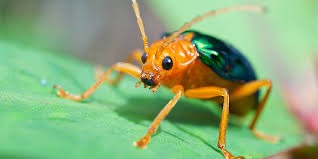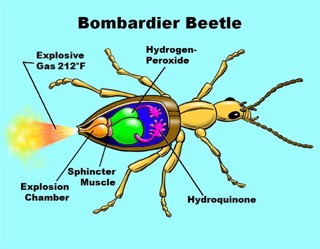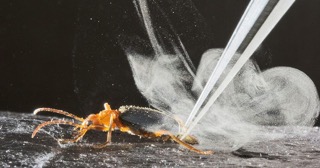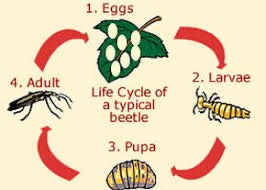Bombardier Beetle
Taxonomy
| Kingdom | Phylum | Class | Order | Family | Subfamily | Genus | |
|---|---|---|---|---|---|---|---|
| Classification | Animalia | Arthropoda | Insecta | Coleoptera | Carabidae | Brachininae | Brachinus |
The Genus Brachinus is home to over 500 different species of Bombardier Beetles. [1]

Body Structure

Bombardier Beetles are small beetles that don't grow over an inch in size. They have orange arms, thorax, and limbs with blue wing coverings. Their body shape and looks are common, and not much different from many other beetles, having six legs and two antennas [2]. Bombardier Beetles get their name from their special ability or "bomb," which is inside their abdomen. Inside their body, they have two chambers, one containing hydrogen peroxide and one with hydroquinone. When the beetle feels it is being threatened, it excretes some of both, creating a chemical reaction in their reaction chamber [3]. This reaction can be shot out of the beetle's anus like a machine gun shooting rapid bursts of oxygen, quinone, and water. These bursts can be up to 20 MPH and 212 degrees Fahrenheit; it shoots in bursts, allowing for the beetle to cool down. This allows the beetle to fend off prey from consuming it such as a frog or a bigger insect. Even when consumed, it is often regurgitated and escapes due to its "bomb" making them unenjoyable prey [4]. These beetle's defense system is so successful that other beetles that aren't Bombardier have started to look like these beetles using Batesian mimicry so that predators will choose a different prey [6].
Habitat and Diet

Bombardier Beetles prefer temperate woodlands and grasslands due to their reliance on hiding under logs and leaf litter. Bombardier beetles are found in North America, South America, Europe, Africa, and Australia [2]. These beetles eat both young insects and detritus, which plays an important role in the decomposition and recycling of nutrients. These beetles rely heavily on their antennae for vibrations as well as eye eyesight and feel to help maneuver and find their food, they usually hunt at night. These beetles prefer moist environments where the soil would have a lot of nutrients on its top layers where these beetles roam [2].
Reproduction & Effect on Environment and Humans

Bombardier beetles produce sexually, producing eggs that the female beetle will often place in tunnels of soil or cracks in wood that have nutrients and water for the eggs when they hatch into larvae. The larvae will then rely on the nutrients in the area and sometimes through molting. The larvae will then shed its skin and develop into a pupa. It will then continue to grow and consume nutrients until it is ready to shed its skin one final time, becoming an adult bombardier beetle. The adult beetle's life span will be 2-3 weeks, in which the beetle will try to find a mate and reproduce. These beetles are not in any danger of extinction currently. The ecology of the Bombardier beetles is said to positively impact soil. Their "bomb" is ineffective on humans but their diet and ability to fend off some predators all make for improvements in their microenvironment. Their diet also consists of many pests that harm the soil and microenvironment they are in [6].
References
- [1] National Geographic. “Bombardier Beetle.” National Geographic, [[1]].
- [2] National Wildlife Federation. “Bombardier Beetles.” National Wildlife Federation, [[2]].
- [3] “Featured Creature: Bombardier Beetle.” Shape of Life, 3 Oct. 2023,[[3]].
- [4] Pappas, Stephanie. “The Machine-Gun Bug.” Smithsonian Magazine, 11 Mar. 2019, [[4]].
- [5] K. R. “Beetle Bomb.” The Scientist, May, 2015 [[5]].
- [6] Poetker, E. 2003. "Brachinus fumans", Animal Diversity Web.[[6]].
- [7]Gabrielle's Insect Biology. “Morphology & Life Cycle of the Bombardier Beetle.” Gabrielle's Insect Biology,[[7]].